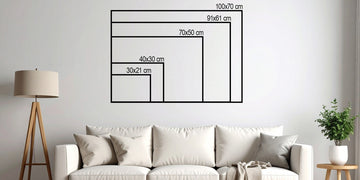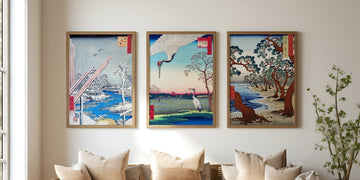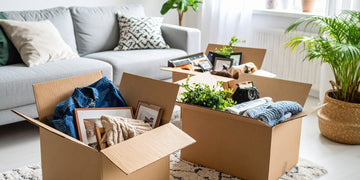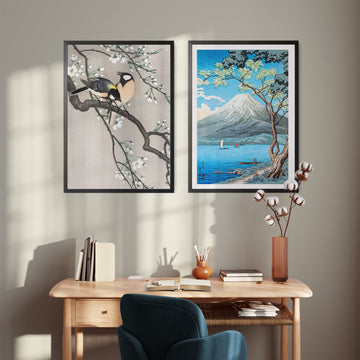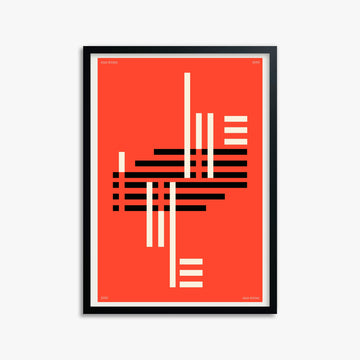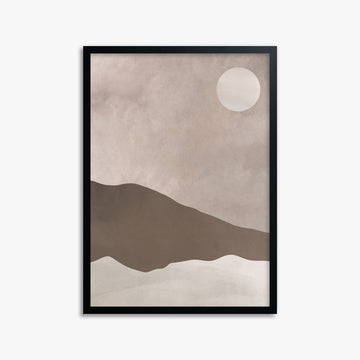Ever bought a poster online, waited excitedly for it to arrive, only to hang it up and realize it looks like a postage stamp on your giant wall? Or worse - ordered what you thought was a "normal" size only to receive something that could double as a tablecloth? We've all been there, staring at our walls in poster-sizing regret.

Choosing the right poster size isn't rocket science, but it does require more thought than "eh, medium sounds good." The wrong size can make your carefully curated space look off-balance, while the perfect size transforms your room from "meh" to "magazine-worthy."
Visual Poster Sizing GuideWe also have an easy visual poster sizing guide, if you have no time to read this blogpost in full, you can check it here: |
Whether you're decorating your first apartment, upgrading your home office, or finally adulting enough to replace those college dorm posters, this guide will help you nail the sizing game every single time.
What are the standard European poster sizes I should know about?
Before we dive into the psychology of poster placement, let's get our sizing vocabulary straight. Here are the most common poster sizes you'll encounter in Europe:


Small Sizes (Perfect for intimate spaces)
- 21×30 cm - Classic A4 format, great for small walls, shelves, or grouped arrangements
- 30×21 cm - A4 landscape, perfect for wide horizontal spaces
Medium Sizes (The sweet spot for most rooms)
- 30×40 cm - Versatile size that works almost anywhere
- 40×30 cm - Landscape version, ideal for above desks or narrow walls
- 50×70 cm - Makes a statement without overwhelming most spaces
- 70x50 cm - Landscape format for big spaces
Large Sizes (For when you want to go big)
- 61×91 cm - Dramatic focal point for feature walls
- 91×61 cm - Landscape version for maximum horizontal impact
- 70×100 cm - Our largest size for truly bold statements
- 100×70 cm - Landscape format for expansive wall coverage above large sofas
Think of these sizes like clothing—you wouldn't wear a crop top to a board meeting or a ballgown to brunch. Context is everything, and so is orientation.
How do portrait vs. landscape orientations change everything?
Here's something most people don't think about: the same dimensions can create completely different feelings depending on whether they're vertical (portrait) or horizontal (landscape). It's like the difference between a tall, elegant mirror and a wide, cozy window.
Portrait Orientation Benefits
- Creates height - Makes rooms with low ceilings feel taller
- Draws the eye upward - Perfect for narrow walls or tight spaces
- Feels more formal - Great for entryways and dining rooms
- Works above tall furniture - Ideal above narrow console tables

Landscape Orientation Benefits
- Emphasizes width - Makes narrow rooms feel more spacious
- Creates calm, stable feeling - Our brains associate horizontal lines with rest
- Perfect above wide furniture - Sofas, beds, and long dressers
- Shows panoramic scenes beautifully - Landscapes and cityscapes shine

Pro tip: A 50×70 cm portrait poster will feel completely different from a 70×50 cm landscape poster, even though they use the same amount of wall space. Choose based on the feeling you want to create, not just the available space.
How do I know what size will work in my room?
The most common mistake people make is choosing poster sizes based on what looks good online rather than what will actually work in their space. Here's how to avoid that trap:
The Two-Thirds Rule: Your poster should take up about 2/3 the width of the furniture it's hanging above. So if your sofa is 180 cm wide, aim for a poster that's around 120 cm wide (hello, 100×70 cm landscape format!).
Ceiling Height Considerations
- 2.4-2.5m ceilings - Stick to 30×40 cm or 50×70 cm to avoid overwhelming the space
- 2.7-3m ceilings - You can go larger with 61×91 cm or 70×100 cm without issues
- Higher than 3m - Go wild with our largest sizes or create dramatic gallery walls
Room Size Guidelines
- Small rooms (under 10 m²) - 21×30 cm to 30×40 cm work best
- Medium rooms (10-20 m²) - 30×40 cm to 50×70 cm hit the sweet spot
- Large rooms (20+ m²) - 61×91 cm to 70×100 cm for maximum impact
The Paper Template Trick: Cut out newspaper or kraft paper to match your desired poster size, then tape it to your wall. Live with it for a few days to see how it feels in the space—this simple hack prevents expensive sizing mistakes.

What size should I choose for above my sofa?
The area above your sofa is prime real estate for wall art, but it's also where sizing mistakes are most obvious. Here's how to nail it:
For 2-Seat Sofas (120-150 cm wide)
- Single poster: 70×50 cm or 50×70 cm portrait
- Diptych: Two 30×40 cm pieces, perfectly spaced
For Standard 3-Seat Sofas (180-210 cm wide)
- Single large poster: 100×70 cm or 91×61 cm landscape
- Diptych arrangement: Two 50×70 cm pieces, spaced 5-10 cm apart
- Gallery wall: Mix of 30×40 cm and 50×70 cm sizes
For Corner Sofas and Sectionals
- Triptych arrangement: Three coordinated pieces spanning the length
- Large landscape: 100×70 cm for dramatic horizontal emphasis
- Asymmetrical gallery: Mix sizes but maintain visual balance
Hanging height rule: The center of your poster should be 145-150 cm from the floor, or 15-20 cm above your sofa back.
How do I size posters for my bedroom?
Your bedroom should feel like a personal sanctuary, and poster sizing plays a huge role in creating that cozy-but-not-cramped vibe.
Above the Bed
- Single bed: 30×40 cm keeps it proportional
- Double bed (140 cm wide): 70×50 cm or 50×70 cm works perfectly
- Queen bed (160 cm wide): 91×61 cm or 61×91 cm creates the right proportion
- King bed (180+ cm wide): Go for 100×70 cm or create a diptych with two 50×70 cm pieces
Bedside Walls
- 21×30 cm or 30×40 cm creates intimate, personal moments
- Perfect for smaller artwork or meaningful quotes
- Keep it simple - bedrooms should promote calm, not visual chaos
Opposite the Bed
- This wall can handle larger pieces since you'll see it when entering the room
- 70×50 cm or 91×61 cm makes a great focal point
- Consider landscape orientation to make the room feel wider
What about small spaces like bathrooms and hallways?
Just because a space is small doesn't mean it should be art-free. These areas actually benefit from thoughtful poster placement:
Bathroom Sizing
- Small bathrooms (under 4 m²): 21×30 cm works best
- Larger bathrooms: 30×40 cm can work, especially if you have a long wall
- Avoid anything larger than 50×70 cm - bathrooms feel cramped easily
- Consider moisture-resistant frames for longevity
Hallway Guidelines
- Narrow hallways (under 1m wide): Create a gallery wall with 21×30 cm and 30×40 cm pieces
- Wide hallways: 30×40 cm to 50×70 cm work well as single pieces
- Long hallways: Series of matching smaller pieces creates flow and rhythm

Entryway/Foyer
- Small entryways: Single 40×30 cm or 70×50 cm piece
- Large entryways: 91×61 cm or 100×70 cm makes a great first impression
- This is your chance to set the tone for your entire home
Should I go big or create multi-piece arrangements?
This is the eternal interior design debate: one statement piece or multiple coordinated pieces? The answer depends on your space, style, and commitment level.
Go Big When
- You have a large, empty wall that needs a focal point
- Your room has minimal other decor
- You want maximum impact with minimum effort
- Your space has clean, minimalist vibes
Create Multi-Piece Arrangements When
- You have multiple pieces you love
- Your space has lots of architectural details
- You want to add visual interest to a boring wall
- You enjoy rearranging and updating your decor
Diptych Arrangements (Two Pieces)
- Matching sizes: Two 50×70 cm pieces work beautifully above sofas
- Spacing: Keep 5-15 cm between pieces depending on their size
- Themes: Coordinating colors, subjects, or styles create cohesion
Triptych Arrangements (Three Pieces)
- Perfect for long walls: Three 30×40 cm or 50×70 cm pieces
- Above sectionals: Creates balance with large furniture
- Storytelling: Sequential images or complementary themes
Gallery Wall Guidelines
- Plan the overall footprint first - treat multiple pieces as one large unit
- Keep 5-10 cm between pieces - any closer feels cramped, any farther feels disconnected
- Mix sizes thoughtfully - use one larger piece as an anchor, fill in with smaller ones
- Maintain visual balance - distribute visual weight evenly across the arrangement
How do I avoid the "Floating Postage Stamp" look?
Nothing screams "amateur decorator" like a tiny poster floating alone on a massive wall. Here's how to avoid this tragic mistake:
Solutions for Small Posters on Big Walls
- Group multiple small pieces together - three 21×30 cm pieces can equal one 50×70 cm impact
- Create visual anchors - place near furniture, corners, or architectural elements
- Build a gallery wall - start with larger pieces and fill in with smaller ones
- Use the rule of odd numbers - groups of 3 or 5 pieces feel more natural than even numbers
The Goldilocks Principle: Your poster shouldn't be so small it disappears or so large it overwhelms. It should be just right for your space and make you happy every time you see it.
What's the deal with framing and how does it affect size?
Here's where things get interesting - the right frame can completely change how your poster size works in your space, but that's a topic worthy of its own detailed guide.
For now, just know that framing choices significantly impact how your chosen size will look and feel in your room, so factor this into your decision-making process.
How do I measure my space like a pro?
Before you order anything, grab a measuring tape and become best friends with your walls. Here's your step-by-step measuring guide:
What to Measure
- Wall dimensions - height and width of the entire wall in centimeters
- Furniture dimensions - width of sofas, beds, desks, etc.
- Ceiling height - affects how large you can go
- Existing decor - account for lamps, plants, or other wall-mounted items
Measuring Tools You Need

- Measuring tape (metric, obviously)
- Level for straight hanging
- Pencil for light marking
- Painter's tape for testing layouts
- Your phone camera to document different arrangements
The Paper Template Trick
Cut kraft paper or newspaper to match your desired poster size and tape it to the wall. This lets you:
- See the actual size in your space
- Test different heights and positions
- Compare portrait vs. landscape orientations
- Get input from family/flatmates
- Make sure you love it before ordering
What are the most common sizing mistakes to avoid?
Learn from the poster-sizing failures of others. Here are the mistakes that trip up even well-meaning decorators:

Mistake #1: Going too small for the space
-
The fix: When in doubt, go one size larger rather than smaller
Mistake #2: Ignoring furniture proportions
-
The fix: Always consider what's below your poster—use the 2/3 rule
Mistake #3: Wrong orientation for the space
-
The fix: Portrait for height, landscape for width
Mistake #4: Forgetting about multi-piece options
-
The fix: Sometimes two 30×40 cm pieces work better than one 50×70 cm
Mistake #5: Ordering without measuring
-
The fix: Measure twice, order once—in centimeters!
Mistake #6: Choosing size based on price alone
-
The fix: The right size is worth the investment
Ready to choose the perfect size?
Choosing the right poster size isn't about following rules blindly - it's about understanding how size and orientation affect the feeling of your space and then making intentional choices that support the vibe you're going for.
Remember, your walls are a reflection of you, and the right-sized artwork can transform a house into a home. Whether you go big and bold with a 70×100cm statement piece or create an intimate gallery wall with multiple smaller prints, the key is choosing sizes that make you smile every time you walk into the room.
Start with one perfect piece in the right size and orientation, and watch how it transforms your entire space. Trust us - once you experience the magic of properly sized wall art, you'll never go back to guessing.
Ready to find the perfect size for your space? Browse our wide selection of posters available in all European standard sizes, from intimate 21×30cm prints to statement-making 70×100cm pieces. Posters are available both portrait and landscape orientations to suit your space perfectly.
Visual Poster Sizing GuideWe also have an easy visual poster sizing guide, you can access it here: Visual Poster Sizing Guide |

